Perhaps it is not surprising, then, that medical centers and medical spas nationwide now offer massage as a form of patient treatment. The American Hospital Association recently surveyed 1,007 hospitals about their use of complementary and alternative medicine therapies; more than 80 percent said they offered massage therapy. Upwards of 70 percent said they used massage for pain management and relief.
The medical community is more accepting of massage therapy than ever before. Should skin care professionals integrate massage therapy into their wellness facility? Consider both the practice's advantages and advice on how to make the most out of massage therapy.
Massage
The physiological effects of classic massage are primarily due to its regulatory influence on muscle tone. Muscular and connective tissues are capable of withstanding loosening and stretching exercises only after a massage. Research has shown that constriction of the capillaries in a muscle causes a high degree of conduction loss and cell degeneration as a result of a decrease in metabolism. Massage regulates muscle tone by enhancing circulation and localized metabolic rates. It also increases the flexibility of the muscle.
An effect on the subcutaneous fat layer and connective tissues, together with increased circulation in the muscles and skin, can be observed. Scientific findings concerning the effects of massage include the promotion of more rapid removal of metabolic wastes, the removal of old adhesions, the effect of reflex massage techniques at distant sites, and the reactive effects on the vascular system and the entire body. One of the most persistent, false impressions between both professionals and clients is the belief that massage is capable of increasing strength. Strengthening, in the physiological sense, is possible solely through targeted, active exercise and systematic training. This is true for both the muscular system and the cardiovascular system. However, a massage can prepare the body for strengthening exercises by promoting the removal of waste materials in muscles and connective tissue. Moreover, massage has a positive effect on the human psyche. If performed correctly, it promotes relaxation, calm, and a general sense of well-being. During the course of a treatment program, clients will probably experience one or more of the following techniques: shiatsu, Swedish massage, reflexology, deep fascia manipulation, underwater wand massage, athletic massage, cranial sacral therapy, heller and trager work, watsu, jin shin jyutsu, and Rolfing.
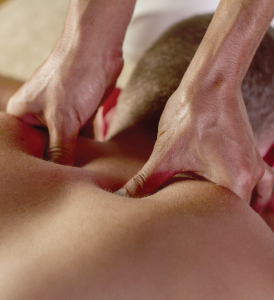 Shiatsu
Shiatsu
Shiatsu is a traditional Japanese massage technique developed from ancient Chinese acupressure and based on energy flow through pathways in the body. These energy pathways, or meridians, are usually divided into six passive and six active groups, which are related to particular organs and an interactive energy flow. Shiatsu uses hand manipulation to exert pressure, ranging from gentle to strong, on “trigger” points along the meridians. This pressure stimulates, calms, and/or harmonizes the functions of both the body and mind, thus promoting and resulting in relaxation and reduction of stress. Shiatsu, by manipulation of pressure points along the meridians, balances the body’s energy flow and eliminates the possible existence of energy blockages.
Swedish Massage
This type of massage, based on a technique developed in 1812 by Per Henrik Ling, manipulates each part of the body through individual muscles by using percussive, tapping movements designed to stimulate the nervous system (a rolling movement of the fingers and vibration of the body.) A special formula of naturally-enriched massage oil or cream, beneficial for the skin, is used to reduce friction for smooth and gliding strokes. Applying a heat pack or using a sauna, whirlpool bath, or a hot shower to warm up the body before this massage is suggested.
Reflexology
Early Chinese healers subscribed to the theory that the feet are, so to speak, the body’s computer; all energy pathways throughout the body converge in the feet and a corresponding reflex point in the feet represents each organ of the body. Reflexology uses pressure, rubbing, pulling, and massage of the proper points of the feet and ankles to release blockages in the corresponding organ. Where indicated, kinesiology, the science dealing with the interrelationship between physiological processes and anatomy with respect to movement, is also used to complement proper energy flow to achieve a feeling of well-being and aliveness.
Athletic Massage
Athletic massage has been traced back to the Roman Empire. Athletes who participated in sports and gladiators who engaged in physical combat had a soothing massage after a long day of strenuous activity. To this day, professional athletes keep their bodies fine-tuned through massage. The theory of massage is that by working the whole body with deep, penetrating strokes and by the concentration of strokes on a particular muscle group, the muscles are stimulated and loosened. In addition, there is a therapeutic effect on problem areas. This massage can be used for clients that participate in all types of activities, including jogging, tennis, swimming, cycling, gold, and skiing.
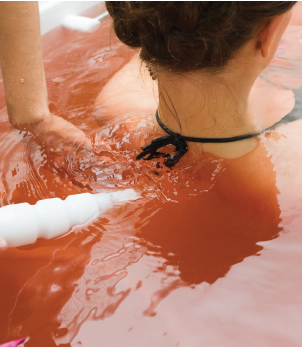 Underwater Wand Massage
Underwater Wand Massage
The therapeutic benefit of the underwater wand massage comes from the relaxing effect of warm water applied at variable force on the muscles, particularly on deep-lying muscle layers, subcutaneous tissues, skin, and the abdominal organs. In the underwater massage, the client lies relaxed in a large tub of warm water. A stream of water, under pressure ranging from 0.5 to a maximum of 7.0 bar absolute pressure units, is applied by means of a hose that has interchangeable nozzles.
Generally, the length of this massage is 20 to 30 minutes. It is necessary for the client to become accustomed to the water for a few minutes before starting the massage. After the massage, the client may want a cold affusion to stimulate circulation. They should then rest for approximately 30 minutes.
Sensitive areas of the body, such as the spinous processed of the spinal column bone spurs, genitalia, anus, back of the knees, and female breasts, should be avoided during the underwater massage. Similarly, the massage is not recommended for any recent, athletic injuries, open wounds, hematomas in an acute state, effusions in the knee joints, acute muscle, ligament, or tendon pulls, and recent fractures.
The following is a list of indications for the underwater massage: fractures, osteosynthesis, dislocation, sprains, contusions in the sub acute stages after a client has been released, sciatica, lumbalgia, brachialgia,
joint and scar contractures, myogeloses, degenerative spinal disorders, chronic joint rheumatism, muscular rheumatism, Bechterev’s disease (ankylosing spondylitis), scoliosis, and flaccid and spastic paralyses. The underwater massage can also be utilized for muscular hypertonia and for uninjured athletes as a warm-down massage after strenuous training and competition.
Watsu
Watsu is a bodywork technique that incorporates the moves and stretches of shiatsu while the client is submerged under water. It began when Harold Dull of the School of Shiatsu and Massage at Harbin Hot Springs started floating people and then applying the zen shiatsu techniques he studied in Japan. Watsu has now spread around the world and developed into a powerful form that massage therapists find alleviates a wide range of physical and emotional conditions.
Cranial-Sacral Therapy
Pioneered by William G. Sutherland in the 1920s, cranial-sacral therapy is a branch of osteopathy that focuses on the study of the bones of the cranium and their relationship to ill health. It involves gently guiding and releasing tensions through very mild pressure on the different cranial bones near the sutures of the skull, where one bone lies next to another. Cranial-sacral therapy is reported to be effective in treating headaches, chronic ear infections, deafness, sinusitis, facial pain, and lower back pain.
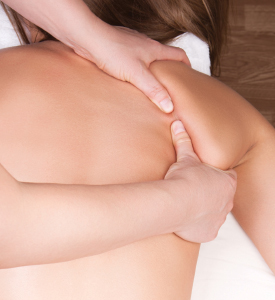 Heller Work
Heller Work
Founded in 1979 by Joseph Heller in the United States, the major components comprising Hellerwork include deep-tissue bodywork affecting the nervous and muscular systems, movement re-education training to learn how to experience the full manifestation of the spirit, and video feedback to view how simple acts of daily life are accomplished.
Trager Work
A bodywork therapy developed by American medical practitioner Dr. Milton Trager in the 1920s, Trager makes extensive use of touch-contact and encourages clients to experience the ‘freeing up’ of different parts of the body. This technique consists of simple exercises called mentastics and deep, non-intrusive, hands-on work. The idea is to use motion in the muscles and joints to produce positive sensory feelings that are then fed back into the central nervous system. The result is a feeling of lightness, freedom, and flexibility.
Jin Shin Jyutsu
A gentle, hands-on ancient healing art, Jin Shin Jyutsu allows the flow of energy to be restored by releasing blockages through touch. Jin Shin Jyutsu’s origins are in the Japanese Kojiki documents of the 7th century. Master Joro Maurai popularized this technique in the early 1920s. In a typical session lasting about one hour, the client remains fully clothed and lies on their back. The practitioner identifies energy blocks by listening to the pulse and then holding two points in combination to release blockages.
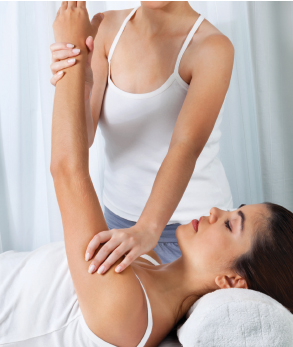 Rolfing
Rolfing
A technique to re-order the major body segments. Swiss-born biochemist Dr. Ida Rolf founded Rolfing in the 1940s. It was further developed in the 1960s in the United States. Rolfing utilizes a deep-tissue massage technique to bring head, shoulders, thorax, pelvis, and legs into vertical alignment. By lifting the head and chest and lengthening the body’s trunk, it allows more efficient use of the muscles with less expended energy. A sense of lightness and greater mobility often result.
Thanks to the dizzying array of options offered at spas, clients often go into their first appointment confused about which type of massage to get. The techniques of a massage treatment have to be adjusted based on what is indicated for the client. This means that spa’s should consider hiring a technician according to the credentials.
References
American College of Physicians. (2008). Massage Therapy May Have Immediate Positive Effect On Pain And Mood For Advanced Cancer Patients. Science Daily.
American Massage Therapy Association, 2014.
AMTA Consumer Surveys, 2014.
AMTA Industry Survey, 2014.
Castro-Sánchez, A.M., Matarán-Peñarrocha, G.A., Granero-Molina, J., Aguilera-Manrique, G., Quesada-Rubio, J.M., Moreno-Lorenzo, C. (2011). Benefits of massage-myofascial release therapy on pain, anxiety, quality of sleep, depression, and quality of life in patients with fibromyalgia. Evidence-Based Complementary Alternative Medicine.
Currin, J. Meister, E.A. (2008). A hospital-based intervention using massage to reduce distress among oncology patients. Cancer Nurse. 31(3), 214-218.
Field, T., Diego, M., Cullen, C., Hartshorn, K., Gruskin, A., Hernandez-Reif, M., Sunshine, W. (2004). Carpal tunnel syndrome symptoms are lessened following massage. Journal of Bodywork and Movement Therapies. 8, 9-14.
Hernandez-Reif, M., Field T., Krasnegor, J., Theakston, H., Hossain, Z., Burman, I. (2000). High blood pressure and associated symptoms were reduced by massage therapy. Journal of Bodywork and Movement Therapies, 4, 31-38.
IBIS World Industry Report OD6028 Massage Services, January 2014.
Perlman, A.I., Sabina, A, Williams, A.L., Njike, V.Y., Katz, D.L. (2006). Massage Therapy for Osteoarthritis of the Knee. Arch Intern Med. 166(22), 2533-8.
Piotrowski, M., Paterson, C., Mitchinson, A., Kim, H.M., Kirsh, M., Hinshaw, D. B. (2003). Massage as Adjuvant Therapy in the Management of Acute Postoperative Pain: A Preliminary Study in Men. Journal of the American College of Surgeons, 197(6), 1037-1046.
Preyde M. (2003) Effectiveness of massage therapy for subacute low back pain: a randomized controlled trial. Journal of Soft Tissue Manipulation, 8, 4-10.
Quinn, C., Chandler, C., Moraska, A. (2002). Massage Therapy & Frequency of Chronic Tension Headaches. American Journal of Public Health, 92(10), 1657-61.
Rapaport, M.H., Schettler, P., Bresee, C. (2010). A Preliminary Study of the Effects of a Single Session of Swedish Massage on Hypothalamic-Pituitary-Adrenal and Immune Function in Normal Individuals. Journal of Alternative and Complementary Medicine, 16(10), 1-10.
Reader, M., Young, R., Connor, J.P. (2005). Massage therapy improves the management of alcohol withdrawal syndrome. Journal of Alternative Complementary Medicine. 11(2), 311-3.
U.S. Department of Labor, Bureau of Labor Statistics, Occupational Outlook Handbook
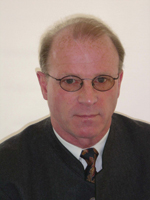 Dr. Reinhard Bergel, president and founder of H-e-a-t. Inc., (Health-enhancement-accessories-training) Spa Kur Therapy Development. He is an advisor in Spa Kur facility development and conducts spa staff training. He has published numerous articles, as well as the comprehensive SPA ENCYCLOPEDIA. Bergel is a founding member of the American Society of Lymphology and American Day Spa Association and has operated a health spa clinic and physical rehabilitation center for almost two decades. He has been practicing and teaching Lymphedema Management since 1986. This email address is being protected from spambots. You need JavaScript enabled to view it.
Dr. Reinhard Bergel, president and founder of H-e-a-t. Inc., (Health-enhancement-accessories-training) Spa Kur Therapy Development. He is an advisor in Spa Kur facility development and conducts spa staff training. He has published numerous articles, as well as the comprehensive SPA ENCYCLOPEDIA. Bergel is a founding member of the American Society of Lymphology and American Day Spa Association and has operated a health spa clinic and physical rehabilitation center for almost two decades. He has been practicing and teaching Lymphedema Management since 1986. This email address is being protected from spambots. You need JavaScript enabled to view it.
Want to read more?
Subscribe to one of our monthly plans to continue reading this article.